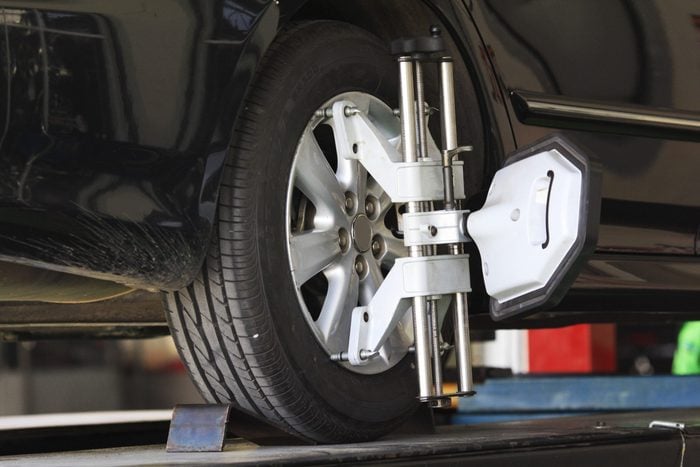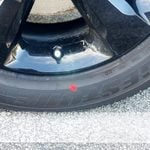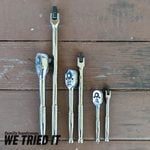Tire Alignment vs. Balance: What’s the Difference?

Properly balanced tires and wheel alignment extend tire life and are important to your overall driving experience. Here's what you need to know.
Modern tires are designed to stick to the road, especially when cornering. Correctly balanced and aligned wheels ensure tires are always in contact with the road surface. This is important because the section of tire that actually touches the road, called the contact patch or footprint, isn’t much larger than the palm of your hand.
Even though tire/wheel balancing and alignment services complement each other to provide a smoother, safer ride, they are technically separate services. They can be performed individually, but most repair shops will perform both services at the same time to ensure customer satisfaction.
Note: When a tire (the rubber part) is mounted on a wheel (the steel part), it’s called a tire/wheel assembly.
What is Tire Alignment?
A tire alignment, also known as a “front-end” or “four-wheel alignment” on cars with independent rear suspension, involves adjusting the angles of the suspension system. There are no adjustments to the tires/wheels themselves.
An out-of-alignment suspension causes excess wear on either edge of a tire. When I was a teacher, I illustrated this for my students with a tapered coffee cup. When I rolled the cup on a table, it would go in a circle, demonstrating the way car pulls to one side of the road when out of alignment.
Properly aligned tires ensure your suspension is precisely, geometrically positioned so your tires all point in the same direction. Called “tracking,” it keeps the tires/wheels firmly planted on the pavement and going straight. That increases tread life and driving enjoyment.
The three common alignment angles are:
- Camber: The inward or outward tilt of the wheel when viewed from the front of the car. Camber distributes the entire load of a vehicle across the tread of a tire. Out of spec camber places the load on only one side of a tire, resulting in premature wear on that side.
- Toe-in/toe-out measurements: The angle/distance between the front of the tires on the same axle when looking at the vehicle from above. When toe-in/toe-out is out of spec, it affects tire wear and handling when going straight or turning.
- Caster: The tilt or angle of the tire/wheel assembly toward (positive) or away (negative) from the steering wheel. Caster doesn’t affect tire wear but impacts handling and steering. After turning, the steering wheel should easily return to the centered position without driver assistance.
Even normal driving on perfect roads causes tire wear. And suspension parts that are constantly moving, ultimately weakening and wearing out, affect a vehicle’s wheel alignment.
Hitting a pothole, bouncing into a curb, or getting walloped in an accident will also throw the suspension out of alignment. That’s why even if your tires are wearing well and your car seems to be driving fine, a tire alignment should be part of your annual maintenance service.
Signs You Need a Tire Alignment
Assuming your tires are inflated to the correct air pressure, your vehicle probably needs a wheel alignment when:
- Your car keeps drifting or pulling to one side of the road.
- You see excessive, abnormal or uneven tread wear, or feather edging across the entire tread face.
- Your tires squeal or squeak when driving or cornering.
- The steering wheel feels “off-center.”
- Your steering wheel vibrates, or your car pulls to one side when accelerating from a stop.
- You notice excess side-to-side steering wheel play
What Is Tire Balancing?
Anything round that spins, like tires and wheels, must be “balanced” or it will vibrate. Wheel balancing corrects this in the tire/wheel assembly.
Tire imbalance results from one section of the tire/wheel being heavier, or lower, than another section. Being out-of-balance can damage and shorten tire life.
To explain wheel balancing to my students, I taped flat washers to a basketball. When rolling the ball, it would “bounce” up and down every time the washers hit the floor, indicating the heavy spot of the ball.
Wheel balancing involves spinning a tire and wheel assembly with a piece of equipment cleverly called a wheel balancer, operated by a trained technician. The most common types of wheel balancing are dynamic and match-balancing.
Dynamic balancing identifies a tire/wheel’s heaviest point and shows where wheel weights need to be installed. These counteract tire imbalance, eliminating vibrations and tire hop.
Match, or road force, balancing identifies the tire’s low and wheel’s high point. To provide the smoothest ride, the technician will loosen the tire from the wheel and line up the two points.
Signs Your Tires Need Balancing
- You feel vibrations while driving. If the front tires are out of balance, the vibrations telescope up through the steering wheel. The seats or floorboards will pulsate if the rear tires/wheel are out of balance.
- You see bald spots on the edge or middle of the tire tread.
- You hear rumbling, growling or thumping noises from the tires.
- You repair a tire with an internal patch or plug.
To extend the life of your tires, provide better handling and braking, a smoother ride and increased fuel economy, be sure to rotate and balance your tires and wheels every 6,000 to 8,000 miles as part of your regular maintenance routine.



